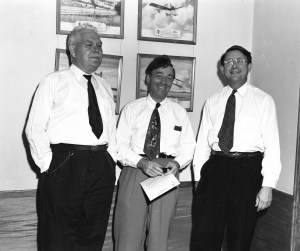
Irving Pinkel Receives His NACA 15-Year Service Award
Irving Pinkel, Associate Chief of the Physics Division at the Lewis Flight Propulsion Laboratory, receives his award and pin for 15 years of service with the National Advisory Committee for Aeronautics (NACA). Laboratory Director Raymond Sharp, left, and Associate Director Abe Silverstein make the presentation. Pinkel commenced his career at the Langley Memorial Aeronautical Laboratory where his older brother Benjamin was a powerplants researcher. The brothers transferred to the new NACA laboratory in Cleveland when it opened two years later. During the World War II, Irving Pinkel concentrated his efforts on the lubrication of hydraulics and oil systems for high altitude aircraft. Pinkel was assigned to the icing research program in the mid-1940s where he worked with the researchers to turn the engineering-based program into a scientific analysis. In 1949 Pinkel was named Associate Chief of the Physics Division where he investigated slippery runways, lightning strikes to aircraft, the jettisoning of fuel in flight, and personally supervised the Crash Fire Test Program. In 1956 Pinkel was named Chief of the Flight Problems Division. Pinkel’s group tackled a number of difficult aeronautic problems during the next 12 years. Pinkel’s crash fire experience was called upon following the deadly Apollo 204 [renamed Apollo 1] fire in January 1967. Within days of the incident Pinkel arrived at Kennedy Space Center to help inspect the damaged capsule, develop a timeline of events, and offer insight into the origin and propagation of the fire. Pinkel spent over a year helping with the redesign of the Apollo capsule and spacesuits. Pinkel was summoned in April 1970 as an official observer to the review board for the Apollo 13 incident. Pinkel retired two years later in 1972 after 32 years of NACA and NASA service.
- X



























